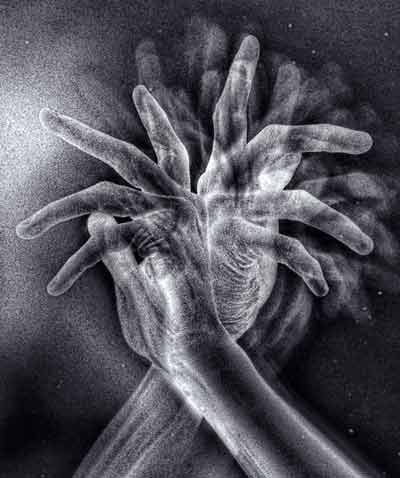
Breath of Wind
Pranayama, it seems, once had a more central place in the practice of yoga than it does these days. While the Yoga Sutras of Patanjali are often cited as
the core yoga text, what is practiced in the name of yoga nowadays, whether on mat or on cushion, bears a more direct resemblance and relationship to more
recent Medieval texts: such as the Hathayoga Pradipika. In this and similar texts considerably more content, in quantity and in detail, is devoted to
regulation of the breath than to postural practices. Nevertheless the Hathayoga Pradipika and other Medieval texts clearly state that Hatha Yoga is a
preparation for Raja Yoga.
At the same time there does seem to be a direct link between the Hatha Yoga methodology of breath regulation known as Pranayama and the presentation of
Pranayama in Patanjali’s Yoga Sutras. Particularly in Yoga Sutra II.50 where Patanjali uses the sanskrit words for ‘place’, ‘time’ and ‘number’. It is not
so hard to link these words to the core aspects of popular Pranayama methodology. Place (desa in sanskrit) can be linked to the four phases of the
breath: inhalation, internal suspension, exhalation and external suspension. Time (kala in sanskrit) can be linked to the length or duration of
the phases of the breath. Number (samkhya in sanskrit) can be linked to the number of rounds, or cycles, practiced.
At first glance this seems to confirm that Hatha Yoga practices are directly related to the older ‘Classical’ yoga presented by Patanjali. This may not be
the case. The issue that we are faced with first is one of translation and interpretation: especially of the Yoga Sutras. To translate a text that concerns
itself with the roots and subtleties of human experience, within which the dynamics of cognition, perception and consciousness are analysed in a way that
relates directly to human experience, we need more than linguistic ability. We need also to have a clear understanding of the territory being analysed.
Modern scholarship does not provide this understanding. It can only be derived from a profound intimacy with human intelligence and its ability to provide
a clear view of the functional dynamics of human cognition. This intimacy is perhaps only provided by deep meditation.
Without adequate depth of experience no amount of linguistic fluency will permit the terse, raw statements of the Yoga Sutras to be accurately interpreted.
This being the case we should perhaps not be surprised were we to find that most, if not all, the interpretations, and even translations, of Patanjali’s
text express the assumptions and prejudices of the commentator rather than the understanding of Patanjali. Indeed, any commentator that does not clarify
that possibility is probably not to be trusted to understand the subtleties of human intelligence. In which case they can hardly be trusted to interpret
the Yoga Sutras.
The eight limbs of yoga, presented by Patanjali in the second and third chapter of the Yoga Sutras, are perhaps the most well-known part of his text. This
does not mean that they are clearly understood. If we go to the sanskrit that Patanjali uses to present the third and fourth limbs, Asana and Pranayama,
then a second issue of intention or technique is brought into the light. Even though Asana is generally considered to be a technique involving the body
there is nothing technical in Patanjali’s words. They are clearly descriptive rather than prescriptive. There is no reference to any specific shapes or
postures at all. Only to experiential qualities.
Given that Patanjali states as the opening to his presentation of Pranayama that it occurs within Asana (tasmin sati), we need to understand what
Asana is if we are to understand what Pranayama is to Patanjali. In effect Patanjali describes Asana in four two-word sutras. The first juxtaposessthiram (steadiness or stability) with sukham (ease, joy). The second juxtaposes prayatna (effort, tension) with saithilya (relaxation, release). The third juxtaposes ananta (endless, infinite) with samapatti (intimacy, merging). The fourth
juxtaposes dvandvha (opposites, dualities) with anabhighatah (immunity, transcendence).
This is quite clearly descriptive rather than prescriptive, describing an experience rather than a technique. An experience within which the body is
perceived in a way radically different from the norm. Most yoga posture practitioners have had this kind of perceptual shift within which their body is no
longer perceived as a finite and precisely located three dimensional structure. In fact this could be the defining characteristic of being “in the zone” or
“in the flow” while on a yoga mat: the perceived character of the body dissolves into an amorphous presence of delight within which the dualistic,
functional and structural, distinctions between left and right, up and down, front and back, forward and backward, inside and outside no longer have any
relevance, or even presence.

Art by Albert Smirnov
If this is the case then Pranayama, according to Patanjali, would be a deepening of this nondual and nonlinear somatic experience by way of awareness of
the breath. Almost any experienced meditator could probably confirm this kind of experience, within which the settling of the body into stillness leaves
its most consistent and obvious sensations being those generated by the breath. Attention is then naturally taken by these sensations towards a deep
intimacy (samapatti) with the presence of breathing. Rather than taking control of the breath, which would not be possible within a somatic
experience without functional and structural reference points, Pranayama would be a natural extension of the dimensionless experience of Asana. The
functional and structural (dualistic) characteristics of the breath would become meaningless, irrelevant and imperceptible while awareness would be
absorbed into the deeper flow of consciousness itself.
Which is exactly what Patanjali states in the last sutra of his presentation of Pranayama. “Dharanasu ca yogyata manasah” makes an explicit link
between Pranayama and the first phase of ‘the meditative mind’, Dharana, which is the sixth limb presented by Patanjali. While this seems to skip over the
fifth limb, Pratyahara, Patanjali nevertheless immediately presents it.
In his presentations of Asana, Pranayama, Pratyahara, Dharana, Dhyana and Samadhi it is very difficult to find either prescription or technique. It is not
so hard to see that Patanjali is describing a step by step infolding of awareness from the body and its breathing via mind and into consciousness. The Yoga
Sutras are a “what is” and “what hapens” map, rather than a “how to” manual.
One possible exception to this descriptive consistency could be in his presentation of Pranayama. Not only in his use of the words desa, kala and samkhya but also, and perhaps more tellingly, in his use of the word viccedah. Four contemporary commentators
(Feuerstein, Stiles, Iyengar and Huston) offer the following English options for this key word: cutting off, cessation, stoppage, interruption.
These words seems to clearly imply intention, regulation and control. Yet this may not be the case. In fact anyone who has experienced a deep infolding of
awareness into the clear presence of consciousness knows that such an event can never be produced by effort nor control. Even the slightest hint of effort,
or intention, maintains mind in its linear, dualistic limitations. Rather the infolding flow of awareness so clearly and elegantly presented by Patanjali,
happens only and exactly because all effort, all intention have been relinquished into the free flowing intelligence of consciousness. This is, of course
what surrender means. Not to submit to some higher power, but to let go of resisting the presence of natural intelligence, where that resistance is most
especially our attempts to make something happen.
Nothing is perhaps more obvious to the contemporary mind than the relevance, even importance of effort and intention. Almost everything we value in our
lives can be linked to them: accomplishments, skills, knowledge, status, wealth. However if we apply this assumption to self-enquiry, or yoga, we find that
it is not only invalid, but that it inhibits our deepest possibilities. In order to understand how this works we need to be able to distinguish clearly
between self-enquiry and self-development. And therefore between Pranayama as self-development, practiced to improve our skills or develop our power, and
Pranayama as self-enquiry where it is simply a means to explore the subtleties of our nature. While self-development can never deliver the fruits of self
enquiry, self-enquiry naturally generates many of the benefits that self-improvement is undertaken in pursuit of: not least clarity, tranquility and
understanding.
While self-development is always undertaken from dissatisfaction, however subtle, in pursuit of a pre-conceived goal, however loosely conceived or defined,
self-enquiry is, and must be, completely open-ended. It must be free from any particular goal, and completely open to whatever may actually exist. If we
apply this distinction to Pranayama we find that the Modern Hathayoga based approach is at odds with the Classical approach of Patanjali: both in its
process and in its possibilities. It is clearly presented, and almost always undertaken, in pursuit of a goal assumed to produce satisfaction and or
fulfillment of some imaginable and idealised kind.
If we go back to the text of Patanjali in the light of this distinction between self-improvement and self-enquiry, we can find radically different
implications to those four words: cessation, place, time and number. Of course we can apply intent to the breath and bring it to an end: for a while.
Likewise we can easily regulate the speed, duration and rhythm of our breathing. All of which take their place in contemporary Pranayama practice.
Nevertheless within the descriptive context of the Yoga Sutras as a whole, and of the eight limbs in particular, another possibility suggests itself. A
possibility based on the intelligence of consciousness, expressing itself through the power of conscious awareness.
At the same time this possibility extends radical and potent possibilities to our experience, both of the breath, and of our deeper contextualising
presence as consciousness expressing itself. In doing so it sheds incisive and consequential light on our nature. While almost everyone knows it is
possible to regulate breathing through the application of intent, almost everyone also knows that simply paying deep and sustained attention to our
breathing transforms it. Of course this transformation does not reflect or express an intentional, preconceived outcome. It is the spontaneous result of
attentiveness. It results from the subtle power of consciousness as conscious awareness.
In Yoga Sutra II.50 the word that follows desa, kala and samkhya, is paridrstah. While Feuerstein, Stiles, Iyengar and Huston, render this as
“regulated”, “measured”, “regulated” and “observed” respectively, it is not hard to see the prejudice in those renderings except that of Huston. Yet, to
suggest that Patanjali is recommending that we simply observe the breath is to classify him as extremely naive in respect of the power and significance of
conscious awareness. As any dedicated meditator can tell you observation of internal phenomena may be calming, but it is a seriously limited application of
the intelligence of consciousness.
Far more potent than maintaining a detached distance between observer and observed is to allow the apparent distinction between them to dissolve into what
Patanjali in Sutras II.25 calls “Kaivalya”. This is the essence of intimacy, or what Patanjali calls, in Sutra II.47, samapatti. The fruition of
internal intimacy is a closing of the habitually experienced separation between observer and observed. In the context of Pranayama, the breather and the
breath become one. The result of this unrestricted intimacy is a deep, clear seeing into the nature of the subject, the object and their apparent
relationship. The illusion of separation is seen through (paridrstah) to its deepest roots. (Yoga Sutras II.20-25)
This suggests another meaning for those four key words that have led to the popularity of breath control under the name of Pranayama. Place, time and
number are the three fundamental classes of the underlying characteristics that constitute any phenomenon. Any phenomenon, whether action, object, event or
situation is uniquely situated in space (desa), in time (kala) and therefor in relation to (samkhya) all other phenomena. What
Patanjali is most likely suggesting is not that we regulate the breath, but that we ‘become one’ with it by becoming intimate with all of its phenomenal
characteristics. That this is so is not only suggested by the non-prescriptive nature of the Yoga Sutras, but also by the nature of human intelligence.

Cognitive intelligence, celebrated and brilliant though it certainly is, is only the tip of human intelligence. Functioning as it does through the
neurological sophistication of the cerebral cortex, it is a direct extension of somatic intelligence. Somatic intelligence is, in and as the human body,
the fruit of 3,500,000,000 million years of evolutionary research and development. While the cognitive intelligence of the human mind is unique and
magnificent in its creativity and power, its effectiveness actually rests on its instability, on its ability to doubt and imagine. Only through the
constant reapplication of imagination and doubt can it arrive at any effective certainty. The somatic intelligence of the body, on the other hand, while
limited in its scope is far more stable and reliable than that of mind. It is constantly, and almost always accurately, gathering, processing and
responding to chemical, mechanical and thermal information so as to keep you alive.
All of this intelligence is impressive enough, and yet there is more, much more, to the intelligence that you are. There is also the intelligent presence
of consciousness, which is the deep ground of both human experience and intelligence. Without the intelligent presence of consciousness there would be no
awareness, no experience, and even no body and nobody to know or experience anything. The intelligence of consciousness is perhaps as different in its
nature and functioning from somatic and cognitive intelligence as they are from each other, without being separate from them. Not least in being entirely
unprejudiced and nonselective. While both body and mind are continuously differentiating and selecting, consciousness is completely open to whatever is
present.
While there is power in the ability of body and mind to distinguish and select, there is a deeper power in consciousness, within its ability to
indiscriminately contain and reveal. This power expresses itself not only in its capacity to generate spontaneous change, but also in the nature of that
change. Just as breathing becomes calmer, smoother, deeper and more efficient in the light of awareness, conscious awareness inherently generates a
momentum towards harmony and wholeness. One way that it does this is by allowing the unhelpful, irrelevant and unncessary to be recognised and
relinquished. This not only disarms the anxious and neurotic habits of mind, but releases its habitually constricted energy into the intelligent presence
of consciousness. This allows the field of conscious awareness to deepen, clarify and stabilise.
Within the context of the breath this takes on very specific implications, directly pointed to by Patanjali in his presentation of Pranayama. Simply
allowing the intelligent power of consciousness to shine as deeply as possible on the presence of the breath brings about profound and even liberating
transformation in mind, body and awareness. Deep attentiveness to the breath begins to reveal the habitual, unconscious tendency to unnecessarily regulate
it. The intelligence of mind begins to recognise not only its subtle impositions on the breath, but also their unnecessary and unhelpful nature. In these
habitually unconscious impulses being brought into the light of awareness they dissolve, while their underlying tendencies (vasana) weaken,
atrophy and eventually dissolve. At the same time mind becomes disinterested in and unable to maintain its ability to distinguish between the dualistic
characteristics of the breath: ihale/exhale, fast/slow, smooth/rough, inside/outside, breather/breath, subject/object. Moreover pauses (cessation,
interruption) between the two phases of the breath (kevala kumbhaka) spontaneously occur.
Any attempt, any intention, to in any way regulate the breath becomes irrelevant and eventually impossible. Both distinction and volition in regard to the
somatic phenomenon of breathing fade away. As they do attention is effortlessly taken into the deeper flows of consciousness by way of Pratyahara and into
the meditative mind. Eventually this intimacy, that began in Asana with the presence of the body, and extends through Pranayama into Samadhi generates a
deep intimacy with our subtle nature as consciousness. This is a very simple, but profound and powerful process that has to be experienced if it is to be
fully understood. It comes to fruition with the integration of the cognitive intelligence of mind in the spiritual intelligence of consciousness. This
allows mind to let go of its need and ability to unnecessarily impose on the intelligence of the body, and on life, while allowing the intelligence of
consciousness to express its intrinsic impulse towards harmony and wholeness more freely and more fully.
While regulating the breath according to preconceived, but impossible to accurately measure, rhythms may well be fascinating, exhilerating and energising,
it depends upon the mind’s superficial and unstable abilities to refine and control. The intelligence of mind, which is naturally unstable and unreliable,
is imposing itself on the intelligence of the body, which is naturally both stable and reliable. In doing so the even more stable and reliable intelligence
of consciousness, and its ability to reveal and harmonise, remains obscured and obstructed. This manipulative approach to Pranayama is a very limited, and
deeply limiting, process that does little more than reinforce and solidify the sense of self as the breather, doer, controller, exciting and impressive
though that may superficially be.
Of course, in all of this is I am affirming and justifying my own prejudices and assumptions. Nevertheless it might be that not all prejudices are equal,
and that some are in fact far closer to the truth than others. For you to know the difference when it comes to Pranayama you may need to become as intimate
as possible not only with your breathing, but also with the dynamics by which it is possible for you to do so: the functional relationship between
cognition, perception, volition and consciousness.
Happy meditating!!!